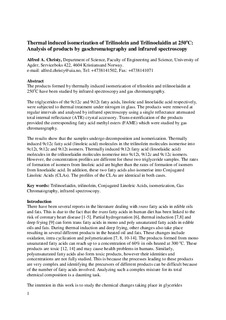Thermally Induced Isomerization of Trilinolein and Trilinoelaidin at 250 A degrees C: Analysis of Products by Gas Chromatography and Infrared Spectroscopy
Original version
Christy, A. A. (2009). Thermally Induced Isomerization of Trilinolein and Trilinoelaidin at 250 A degrees C: Analysis of Products by Gas Chromatography and Infrared Spectroscopy. [Article]. Lipids, 44(12), 1105-1112. doi: 10.1007/s11745-009-3363-xAbstract
The products formed by thermally induced isomerization of trilinolein and trilinoelaidin at 250 A degrees C were studied by infrared spectroscopy and gas chromatography. The triglycerides of the 9c12c and 9t12t fatty acids, linoleic and linoelaidic acid respectively, were subjected to thermal treatment under nitrogen in glass. The products were removed at regular intervals and analysed by infrared spectroscopy using a single reflectance attenuated total internal reflectance crystal accessory. Trans-esterification of the products provided the corresponding fatty acid methyl esters which were studied by gas chromatography. The results show that the samples undergo decomposition and isomerization. Thermally induced 9c12c fatty acid (linoleic acid) molecules in the trilinolein molecules isomerize into 9c12t, 9t12c and 9t12t isomers. Thermally induced 9t12t fatty acid (linoelaidic acid) molecules in the trilinoelaidin molecules isomerize into 9c12t, 9t12c and 9c12c isomers. However, the concentration profiles are different for these two triglyceride samples. The rates of formation of isomers from linoleic acid are higher than the rates of formation of isomers from linoelaidic acid. In addition, these two fatty acids also isomerize into conjugated linoleic acids (CLAs). The profiles of the CLAs are identical in both cases.
Description
Accepted version of an article published in the journal: Lipids
The original publication is available at www.springerlink.com, http://dx.doi.org/10.1007/s11745-009-3363-x
